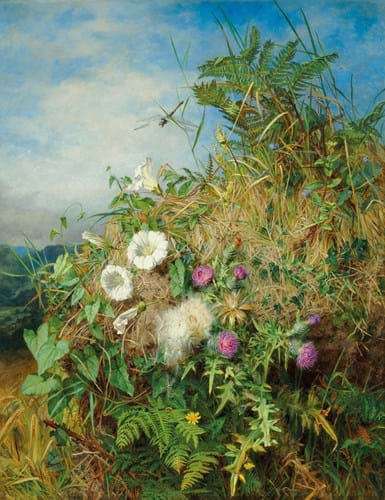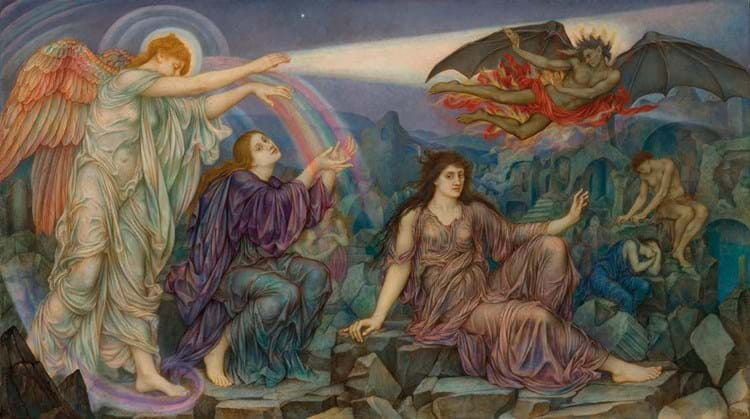Once a mainstay of the Victorian art market, Isabel Goldsmith has been a passionate collector in this field for a long time.
Known to be a committed and informed buyer with a good eye, she has not only supported the sector with her acquisitions but also through donations to institutions such as the Watts Gallery in Surrey.
However, like some other important players in the market, she has now scaled back her purchasing and, indeed, has become more of a seller than a buyer in recent years.
With the market becoming more selective and many wealthy collectors now ploughing their money into other areas, dealers and supporters of the Victorian picture market often look back to the halcyon days when she, together with Christopher ‘Kip’ Forbes, Lord Lloyd Webber and John Schaeffer, formed a quartet of major buyers who helped revive the entire 19th century sector in the 1980s-90s.
The daughter of Sir James Goldsmith, the businessman, financier and founder of the short-lived Eurosceptic Referendum Party, she inherited a significant share of his £1.2bn estate on her father’s death in 1997. Earlier she had also inherited a major fortune from her maternal grandfather, the Bolivian tin magnate Antenor Patiño (himself a major collector of French furniture, works of art and silver).
Buying from both dealers and auctions, Isabel Goldsmith formed one of the world’s leading collections of works by the Pre-Raphaelites and their followers, as well as their earlier classical forebears and representatives of the wider European symbolist tradition. Working with the influential British designer and antiques dealer Geoffrey Bennison, she turned her Victorian home in South Kensington into an eyecatching setting for the Pre- Raphaelites.
Video promotion
Since 2005 Goldsmith has sold a number of works from her collection with Christie’s (26/20/14.5% buyer’s premium). Most recently the auction house offered a large group of her pictures for the first time in a dedicated online sale that closed on July 14.
In a pre-sale promotional video on Christie’s website, Goldsmith said that having moved from her house to a smaller apartment, it was the right time to sell the works.
With 86 Pre-Raphaelite and Symbolist works on offer at the auction, 68 lots sold (79%) for a £1.53m total including premium.
The sale might not have included some of her most significant works but the spread of material represented over 40 years of collecting and gave the opportunity to test the temperature of the broader sector.
Although a number of dealers felt the bidding was a bit flat in places and some prices on the low side, the best of the collection seemed to show values holding up better than might have been expected considering the difficult state of the market.
De Morgan discovered
The top lot was a small work on paper by Fernand Khnopff (1858- 1921), La Médusa endormie from c.1896 that made £280,000 against a £200,000-300,000 estimate. It was pictured in News Digest, ATG No 2554.
Goldsmith had purchased it at Christie’s back in 1988 for a hammer price of £120,000 – approximately £270,000 in today’s money adjusting for inflation.
Two works by Evelyn De Morgan (1855-1919) also both sold but met with contrasting reactions in terms of bidding. Their performance seemed to underline the selectivity present in the sector even for an artist who has been gaining prominence over the last decade both commercially and curatorially.
Goldsmith bought De Morgan’s works long before the #MeToo movement gave greater focus to overlooked women artists. She discovered De Morgan in the early days of her collecting when she started out buying prints, frequenting London markets such as Bermondsey.
Edward Burne-Jones was her favourite artist so De Morgan, who was a friend and follower of the influential Victorian aesthetic painter, was a natural extension.
In the above-mentioned video, Goldsmith said she was attracted to De Morgan’s “extraordinary colourful vision” and was “very inspired by the fact that she was a female artist”.
As she graduated to buying paintings, she purchased The Search-Light in 1983, paying £11,880 including buyer’s premium at Christie’s. It was one of the artist’s works borne out of the devastation of the First World War, but also containing a spiritual element about enduring hope. It was painted during the conflict and was originally shown at the Red Cross exhibition of 1916.
The painting shows an angel shining her bright search light on the devil. Goldsmith said: “The Search- Light is about good overcoming evil and I thought was good ‘feng shui’ for my home.”
The 2ft 1in x 3ft 8in (64cm x 1.12m) oil on canvas was estimated at £70,000-100,000, which proved a bit too much for one of the artist’s late works, and it was knocked down at £60,000. Although selling under estimate, the price was above the 1983 level when adjusted for inflation.
The other work by De Morgan was also a striking painting that appeared in the same Red Cross exhibition. The Field of the Slain was even more overtly connected to the horrors of the war with dead bodies littering the muddy ground and an angel gathering up their souls.
The work was closely tied-in with De Morgan’s Spiritualist beliefs. Spiritualism had arrived in Britain from the US in the middle of the 19th century and communicating with souls of the dead was a central tenet of its creed.
When the picture last appeared at auction at Sotheby’s New York in 1987, it had been incorrectly identified as The Angel of Death, the title of two other works by the artist. Back then it had sold at $9000 (£5500). The picture’s history and correct title was subsequently uncovered and Goldsmith had bought it from New York dealer Barry Friedman.
Here the 2ft x 19¼in (62 x 46cm) oil on canvas was estimated at £30,000-50,000 and, judged to be a more important work in the artist’s canon, drew greater interest and sold at £70,000.
The price, which stands within the top 10 auction results for De Morgan (source: Artprice), was particularly strong given its smaller format and here again represented an improvement in value over the three decades even accounting for the current high levels of inflation – something that cannot be said for every picture in the Victorian market.
Rated by Ruskin

Wild flowers at the corner of a cornfield, an oil on canvas by Martha Mutrie – £40,000 at Christie’s.
Elsewhere in the Goldsmith sale, a painting of wild flowers at the corner of a cornfield by Martha Darley Mutrie (1824-85) attracted interest against a £30,000-50,000 pitch. Works by the artist seldom appear and this was a particularly admired example.
Along with her younger sister Annie Mutrie (1826-93), she studied under George Wallis at the Manchester School of Design and specialised in flower subjects. John Ruskin described Martha’s pictures as “nearly as good as simple flower painting can be”. He was attracted to the rich colours and details to the petals which were exemplified by this picture.
The 2ft 8in x 2ft 1in (82 x 64cm) oil on canvas had set the highest price for the artist when Goldsmith bought it at Christie’s in 1994 where it was knocked down at £22,000.
This time around it was estimated at £30,000-50,000 and sold on mid-estimate, breaking its own auction record. However, in this case, the £40,000 price represented a marginal decline in value over the 28-year intervening period.
When asked by ATG whether more works from the Goldsmith collection were due to be offered at a future date, a Christie’s spokesperson said there was nothing more to come at present. However, while they would no doubt be extremely keen to sell more works on her behalf, both auctioneers and dealers know what the Victorian market really needs is another buyer like her.
Keeper of the flame
When Isabel Goldsmith bought The guarded flame, a watercolour by Henry Ryland (1856-1924), at Sotheby’s in 1979, she and the interior designer Geoffrey Bennison decided to use it as the starting point for revamping her South Kensington home.
“The beautiful velvet textile in background of this watercolour inspired us to create a setting for the Pre Raphaelites,” she said.
Forty-three years later, the picture was among the 86 Pre-Raphaelite and Symbolist works from her esteemed collection on offer at Christie’s in a dedicated online auction.
The 20¼x 12in (51 x 30cm) pencil, watercolour and bodycolour heightened with gum arabic was executed on paper that had then been laid on panel and housed in a tabernacle frame. A depiction of a single figure with classical and religious motifs, as well as featuring detailed floral patterns to the background, The guarded flame was a vintage example containing the artist’s most familiar themes.
Ryland, who had trained at the South Kensington School of Art before going to Paris and studying at the Académie Julian, was heavily influenced by the Pre-Raphaelites and neo-Classicists such as Sir Lawrence Alma-Tadema (1836-1912) and Albert Moore (1841-93).
In attractive condition, this work overshot a £20,000-30,000 estimate and was knocked down at £50,000 to a UK private buyer, setting a record for Ryland at auction.

















